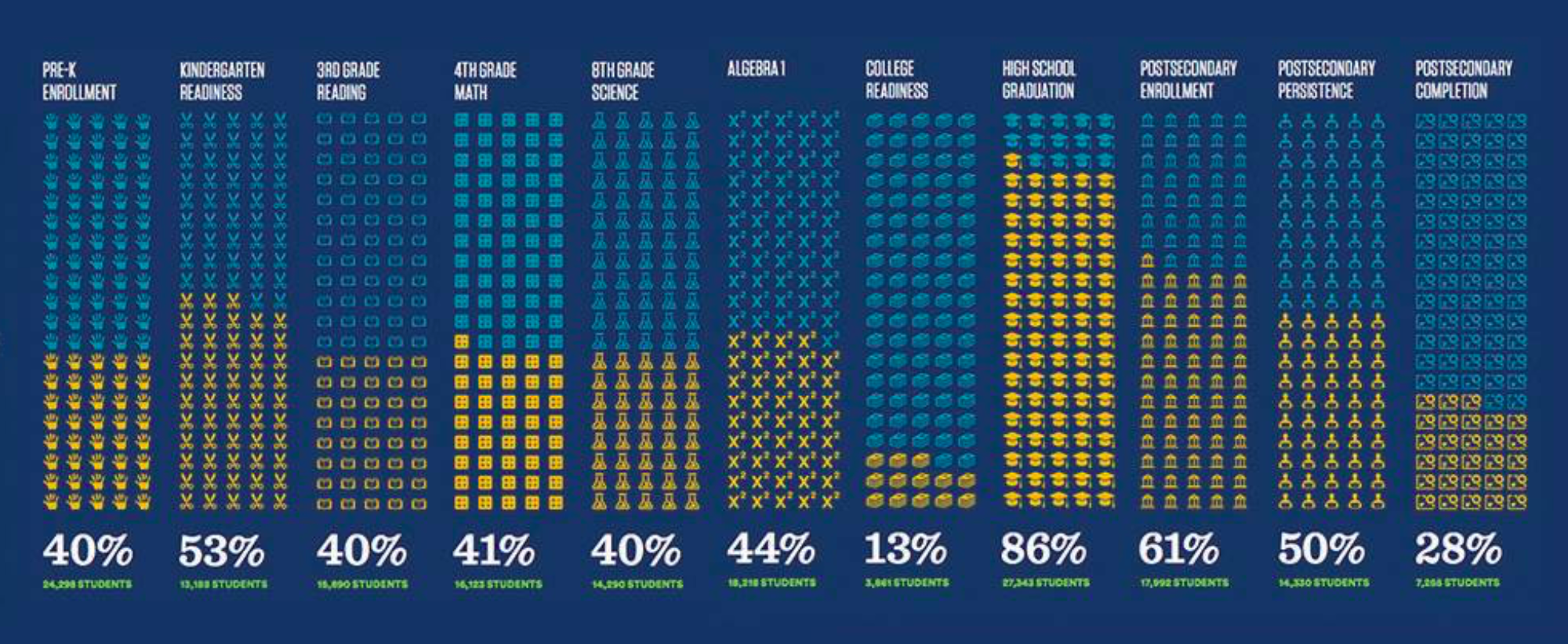The Commit Partnership is focused on the powerful idea that every child in Dallas County should receive an excellent and equitable education, preparing them to flourish at the collegiate level and beyond.
We believe that every child is born with infinite potential, regardless of the zip code they are born into, their household income, or skin color. But due to structural inequities and systemic challenges in our county, not every child has access to the equal or even adequate opportunities.
And for the last six years, over 200 partners, including public and private schools, colleges and universities, foundations, nonprofits, and businesses have been measuring student progress and helping mobilize community action across 11 indicators that reflect key milestones in a student’s educational journey.
To target the root causes hindering student outcomes, three unique coalitions have been created to focus efforts where they are needed most: Our flagship coalition, Early Matters Dallas, focuses on improving early childhood outcomes from birth through 3rd grade, while our second coalition, Best in Class, in partnership with the Communities Foundation of Texas, aims to increase the number of effective and diverse campus educators serving DFW’s 1.2 million students. Our third initiative, Dallas County Promise, seeks to align our local higher ed institutions to incentivize and support every student to access and complete a quality college certificate or degree.
We have focused on 11 indicators to insure that our collective efforts are appropriately focused on improving achievement for every student. Our indicators reflect key milestones in the educational journey and are intended to mobilize community action to address the greatest gaps and opportunities.
The Scorecard was never designed to be simply a reflection of student performance. We know that far too many of the public school students in Dallas County don’t start this journey on a level playing field. We acknowledge the systemic impact that poverty and under resourcing have had in creating profound obstacles for our students to overcome.
The Scorecard is a measure of our impact as a community, as adults, to change the outcomes for every single one of our 501,000 public school students in Dallas County. And we are more confident today than when we started this work 6 years ago that our collective efforts are working.
Download a complete copy of our 2017 Community Achievement Scorecard.

The percentage of Pre-K enrollment for eligible 3 and 4 year olds is up 1 percent from 2016 and 4 percent since our formation in 2012. And as we actively plan for the upcoming Pre-K enrollment campaign in April, we have school districts across the county coming together to collaborate in new and exciting ways to make sure that every eligible family is aware of this important on-ramp to school readiness.
And while the percentage of students who tested at the Kindergarten Readiness level is down 3% from 2016, it is up 10% from 2012.
3rd Grade Reading is up 1% since 2016, and 5% since 2012. But we still have 24,106 3rd graders in Dallas County who are not reading on grade level. This is a critical area of focus, because until the end of 3rd grade, students are learning to read. But in 4th grade students begin reading to learn.
4th grade math is up 7% since 2016, and 14% since 2012.
8th grade science showed no growth from 2016, but is up 11% since 2012.
Algebra One is up 2% since 2016, and 11% since 2012.
College readiness is an area for significant concern, as just 13% of Dallas County seniors are achieving this mark based on current standards. That is down 1% since 2016..
However, high school graduation rates are up to 86%, which is up 4% since 2012.
Postsecondary Enrollment declined by 1%, while Postsecondary Persistence and Postsecondary completion each declined by 2%.
While there is still significant work for us to do as a community to insure that every child has access to an excellent education, there are lots of reasons to be encouraged about our progress. 37,038 additional students are meeting benchmarks since 2012, and districts across the county are making significant improvements to give every child, regardless of race, gender, or zip code, an excellent education.




